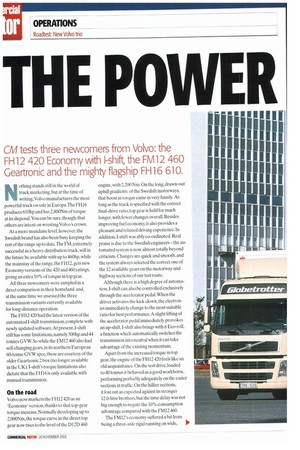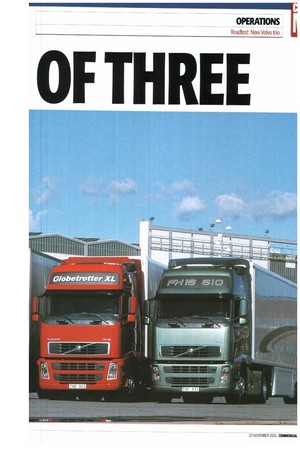THE POWE R
Page 56

Page 57

Page 58

Page 59

If you've noticed an error in this article please click here to report it so we can fix it.
F THREE
CM tests three newcomers from Volvo: the FH12 420 Economy with 1-shift, the FM12 460 Geartronic and the mighty flagship FH16 610.
N°thing stands still in the world of truck marketing. but at the time of writing,Volvo manufactures the most powerful truck on sale in Europe.The FH16 produces 610hp and has 2,800Nm of torque at its disposal.You can be sure. though. that others are intent on wresting Volvo's crown.
At a more mundane level, however, the Swedish brand has also been busy keeping the rest of the range up to date.The FM.extremely successful as a heavy distribution truck, will in the future be available with up to 460hp. while the mainstay of the range, the FH12.gets new Economy versions of the 420 and 460 ratings, giving an extra 10% of torque in top gear.
All three newcomers were sampled in a direct comparison in their homeland and, at the same time we assessed the three transmission variants currently available for long-distance operation.
The FH12 420 had the latest version of the automated I-shift transmission,complete with newly updated software.At present.1-shift still has some limitations, namely 500hp and 44 tonnes GVW. So while the FM12 460 also had self-changing gears, in its northern European 60-tonne GVW spec, these are courtesy of the older Geartronic 2 box (no longer available in the UK),I-shift's torque limitations also dictate that the F1116 is only available with manual transmission.
On the road
Volvo now markets the FH12 420 as an 'Economy' version. thanks to that top-gear torque increase.Normally developing up to 2,000Nm, the torque curve in the direct top gear now rises to the level of the D12D 460 engine. with 2,200 Nm. On the long, drawn-out uphill gradients of the Swedish motorways. that boost in torque came in very handy. As long as the truck is specified with the correct final-drive ratio.top gear is held for much longer, with fewer changes overall. Besides improving fuel economy, it also provides a pleasant and relaxed driving experience. In addition, I-shift was ably co-ordinated. Real praise is due to the Swedish engineers — the automated system is now almost totally beyond criticism. Changes are quick and smooth, and the system always selected the correct one of the 12 available gears on the motorway and highway sections of our test route.
Although there is a high degree of automation, I-shift can also be controlled exclusively through the accelerator pedal.When the driver activates the kick-down, the electronics immediately change to the most suitable ratio for best perforrnance.A slight lifting of the accelerator pedal immediately provokes an up-shift. I-shift also brings with it Eco-roll, a function which automatically switches the transmission into neutral when it can take advantage of the existing momentum.
Apart from the increased torque in top gear, the engine of the FH12 420 feels like an old acquaintance. On the test drive,loaded to 40 tonnes it behaved as a good workhorse, performing perfectly adequately on the easier sections in traffic. On the hillier sections, it lost out as expected against its stronger 12.0-litre brothers, but the time delay was not big enough to negate the 10% consumption advantage compared with the FM12 460.
The FM12's economy suffered a bit from being a three-axle rigid running on wide, low-profile 385/55 R22.5 tyres on the front axle, with 315/70s on the rear wdes.A drawbar trailer with three close-coupled axle increases the rolling friction a bit more.
Overall, during the test travels, the combination proved somewhat nervous, as the wide front tyres followed each rut and the long drawbar of the trailer repeatedly tried to steer the prime mover from the back. However, the ride comfort of the drawbar unit was altogether better than the much shorter-wheelbase tractors. While the steering of the FH12 420 was rather indirect and over-assisted, the FM12 460 required heavier steering inputs and with less self-centring characteristics.
Because the prime mover is designed for a 60-tonne gross weight, the older but stronger Geartronie is used in the FM.Although Geartronic's ratio changes are just as smooth as those of the new I-shift. they are noticeably more leisurely,and the degree of intelligence of the Geartronic is definitely lower. On the hills, the driver benefits from selecting the 'Power' mode, which enables the system to react more satisfyingly to instructions from the accelerator pedal. Despite a higher power output, the 460hp FM is markedly slower than the 420 FH. which is only partly due to the higher rolling friction.
Driving the FM is generally more pleasing. by virtue of its more direct relationship between driver and road.The FH, with its high and softly sprung Globetrotter XL cab. is a different animal —the cab is inclined in fast curves and, under strong braking,to nodding and swings.The comparison shows the FM cab lobe tautly controlled and, to a large extent, free from independent movements.Although the FM is a firmer proposition, few drivers will complain about the softer nature of the FH, especially the long-distance comfort on well maintained motorways.
While the subtle FH16 badge and the monogrammed stainless steel door handles identify the new flagship to the outside world, small chrome details within the cab, as well as the unique terracotta and grey-trimmed interior. document that here is a special Volvo.
Because the manufacturer doesn't yet have an automatic transmission capable of handling 2,800Nm of torque, the FH16 changes man ually. Compared with the smooth-driving automatic transmissions, this is clearly a significant loss of comfort. Our test example was virtually brand new, with only 6,000km behind it —but even so,it performed impressively
Rising to the challenge
It's no surprise that the biggest benefit of the 16-litre engine is its flexibility. Where the 12litre needs at least 1.000rpm revolutions for a given level of work,800 revs are sufficient with the 16-litre. Hardly more than a single split was necessary in order for the Fl-I16, significantly under-stressed at 40 tonnes. to handle the motorway climbs. But even more impressive than the hill-climbing ability was the performance down the other side. Where normally we'd change down two full gears with the 12-litre trucks, in order to arrive safely in the valley,the FH16 managed everything in top gear. A look at the figures shows why —while the D12D engine with Volvo Engine Brake (VEB) produces barely 390hp of retardation at 2,300rpm, the D16C with VEB counters the force of gravity with a colossal 520hp at the same speed. Even the basic exhaust brake in the FH16 delivers more than 310hp.With both engines. the low noise level remains pleasant, even running with the engine brake at maximum revs. Under power, even if the measured values record an objectively higher noise, the deep, rumbling tones of the big engine sound much better.
Despite the chassis being effectively identical to the weaker FH12, clear differences showed up in the handling. With the FH16.the majority of the engine's extra weight rests on the front axle, where it can become evident. Although it can affect the ride in some situations, the upside is slightly sharper steering than on the 12-litre.The cab oscillations are similarly noticeable.
The brake performances of the three test trucks were equally impressive. Volvo uses large discs. carried on a splined mounting on the wheel hub. free to move in the lateral direction.The stoppers performed strongly. responded quickly and gave good progression. The F1-1 and FM set benchmarks in their own sectors. Under the skin, there are relatively few differences between the two, which share approximately 70% of all components. But the three test trucks were so different that their functions can be clearly identified.
The FM.particularly with 460hp. is the ideal truck for heavy distribution work, with the occasional night out The FH12 420 is a good profitable workhorse which, as a Globetrotter XL. spoils the driver with a high standard of accommodation and comfort. Nobody actually needs the FH16 in the UK, but what the hell. it's fun to drive, anyway! •
































































































































































































